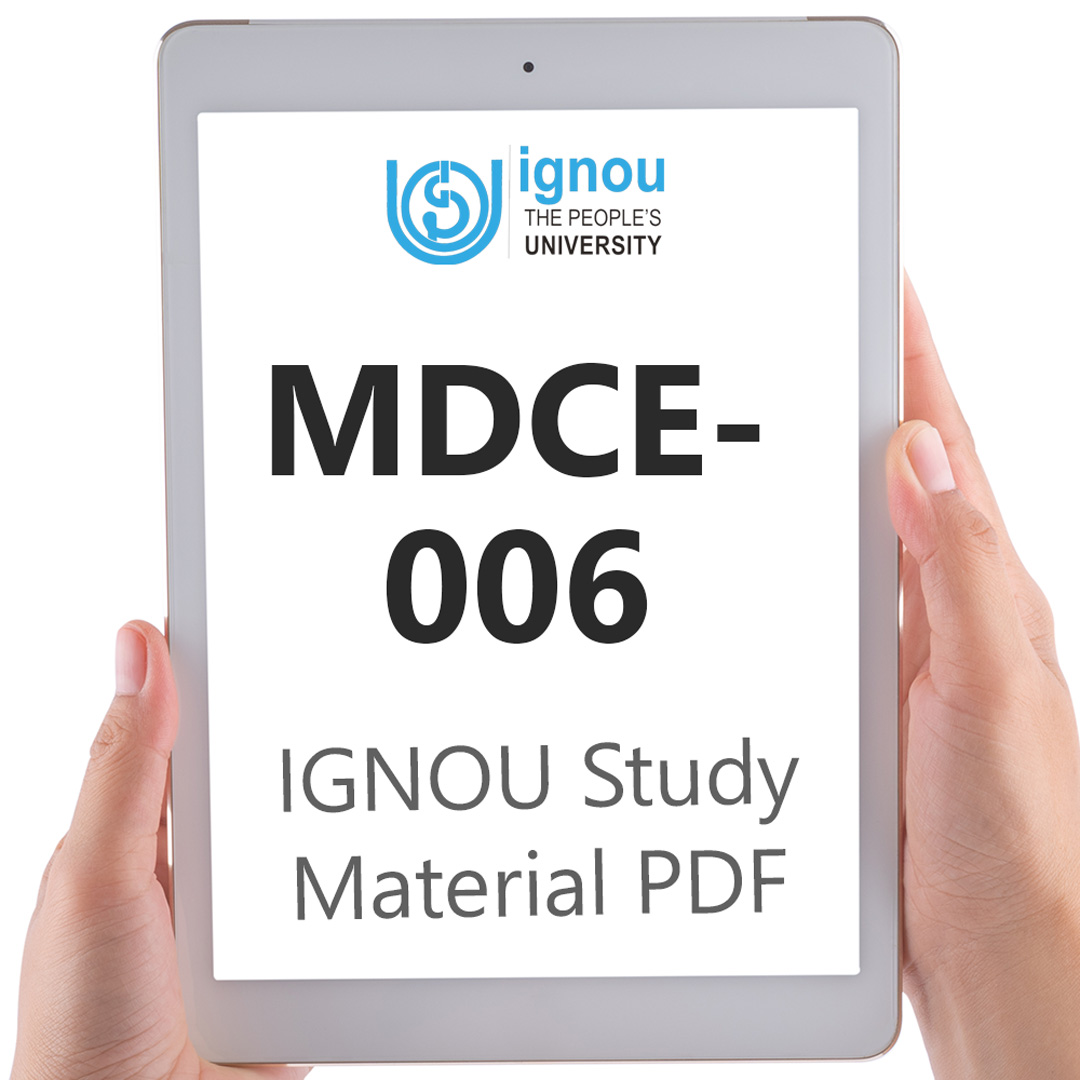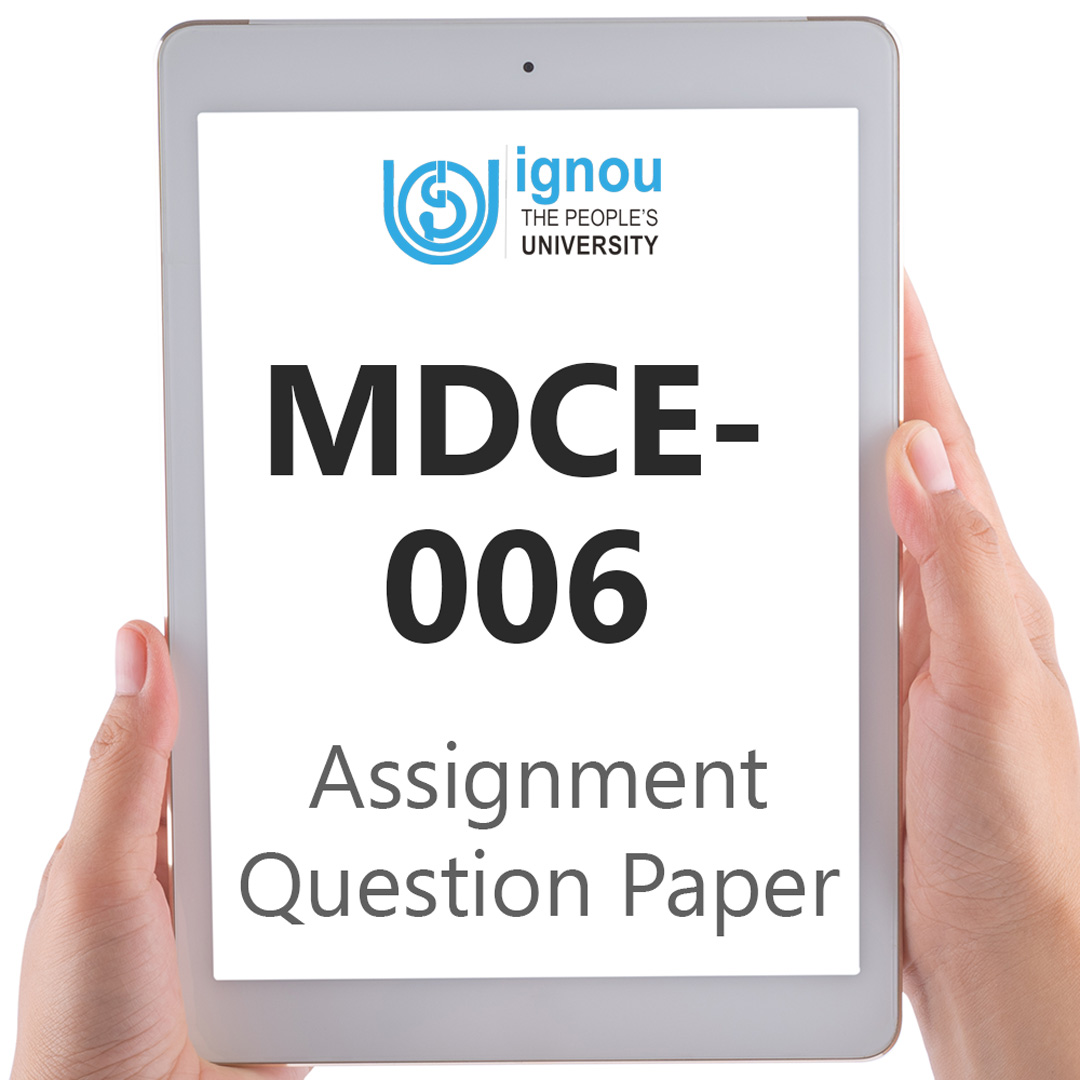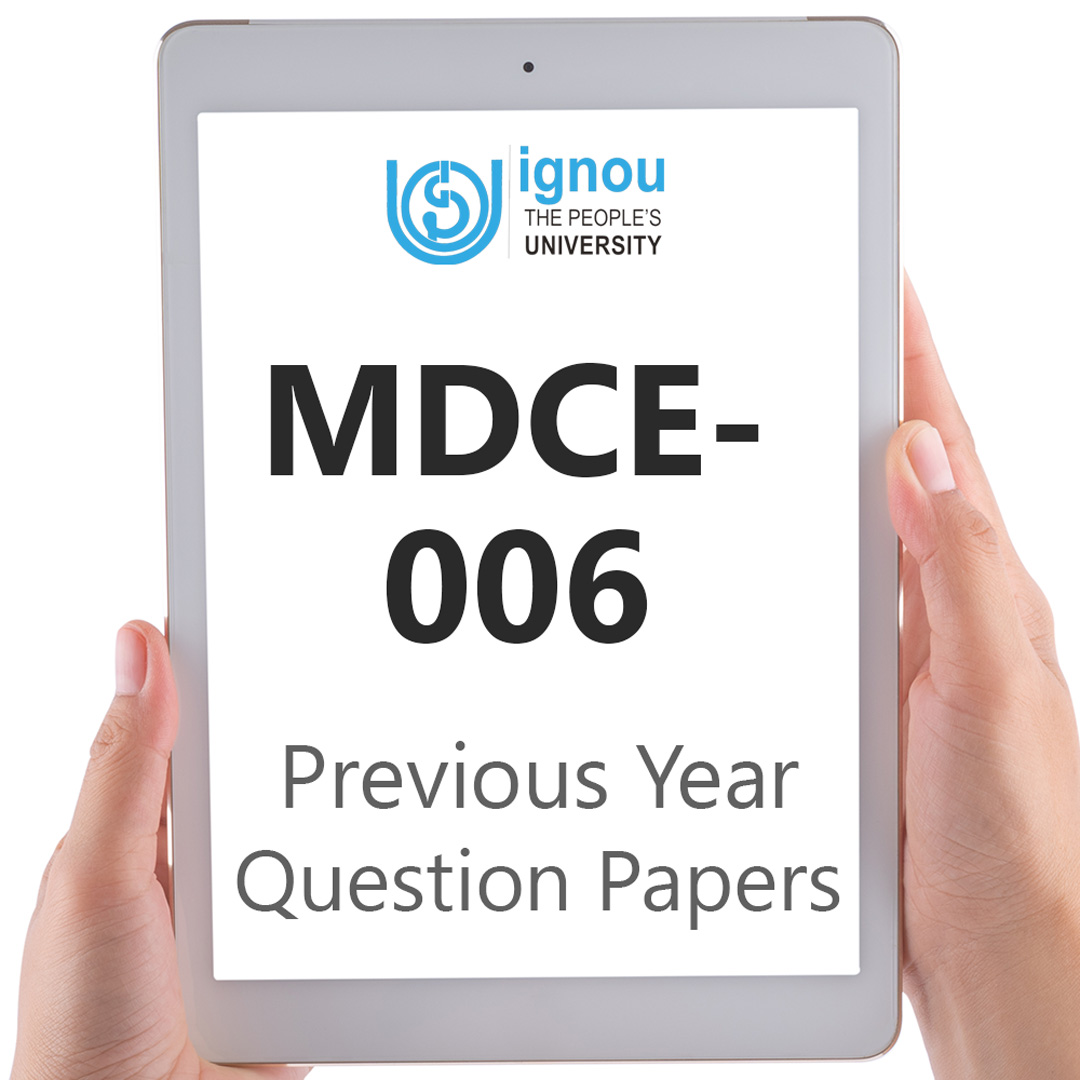If you are looking for MDCE-006 IGNOU Solved Assignment solution for the subject Research Methods in Development Communication, you have come to the right place. MDCE-006 solution on this page applies to 2022-23 session students studying in PGDDC, MADJ courses of IGNOU.
MDCE-006 Solved Assignment Solution by Gyaniversity
Assignment Code: MDCE-006/ July 2022- Jan 2023
Course Code: MDCE-006
Assignment Name: Research Methods in Development Communication
Year: 2022-2023
Verification Status: Verified by Professor
Maximum Marks: 100
Weightage: 30%
Note: Answer all the questions; they carry equal marks. (Answer in 500 Words)
Q1. Discuss need and importance of Research.
Ans) A thorough examination or inquiry, especially one that looks for novel information in any field of study, is what is referred to as research. The word "search" is crucial in this context since, while looking for answers, researchers may never be certain of their exact location or what they will uncover. In reality, the word "research" is made up of the two words "re" and "search," which connote a never-ending quest for the truth and disdain for the current quo. We observe the same emphasis in social science research on testing and validating preexisting hypotheses as well as on inquiry for theory formation. Since the turn of the century, communication as a subject has derived its theoretical underpinnings from both the physical and social sciences and has developed into a multi- and interdisciplinary study.
Any topic can be the subject of study, and we learn about a wide variety of research methods in the news. Breakthrough Cancer-Killing Treatment Has No Side Effects in Mice and "Baby Born with HIV Cured" are two examples of cancer research. Each of these started with a question such, "Does medicine X diminish malignant tissue or HIV infections?" and an issue or a problem (like cancer or HIV). You need to have a problem, concern, or issue that has evolved into a question before you can start your study. These can originate through taking in information from the outside world, previous research, scholarly writing, or from peers. The right question is where research really starts since it needs to be a question that can be answered. The solution to a question like "How can I cure cancer?" cannot really be determined by a study. It's untested and too nebulous.
Whether research is conducted to generate new information or to address problems in the actual world, its ramifications are what matter most.
Research findings must be included into the theory underlying this transdisciplinary and even epistemological inquiry, as well as the conception, design, production, delivery, and assessment of courses and material. The viewpoint must then be fully integrated, and each component must be considered in relation to the others rather than separately at each level of the procedure.
Understanding social order requires research, which is a crucial first step. Complex social phenomena exist. Diverse environmental, psychological, and social variables constantly interact with one another to affect people as individuals, members of social groups, and as a whole society. Therefore, study is required to look into both singular patterns of behaviour and to find recurring patterns of behaviour displayed by cultures and social groups.
Research enables us to comprehend, generalise, predict, and regulate social behaviour by systematically connecting unrelated data.
Numerous social data are produced via research, which aids in the creation of social policies, plans, and objectives. Such information is essential for the wise use of resources and the cogent growth of a society that is rapidly evolving in a country with a diverse cultural population like India.
Research is an ongoing, self-improving process. Its significance stems from the fact that, when done correctly, it can be relied upon. The findings of a research study are grounded in reality since they are the result of logic that was developed via observation and measurement.
Q2. Describe classification of Communication Research.
Ans) There are many ways to evaluate communication research, and there is no one way to categorise it. Research approach classifications vary among communication experts. Depending on how you want to study it, there are various ways to look at it. Communication research can be categorised in a variety of ways, including by design, stage, type, location, and approach. Let's go into more depth about each of them. There could be a little overlap.
Based on Design
It is impossible to categorise communication research in a single method because it can be explored from many different angles. Research approach categories are categorised differently by various communication specialists. How you choose to study it will determine the several angles you can take. Among the ways to categorise communication study are design, stage, nature, setting, and methodology. Let's talk about each one in more depth. Possible overlap exists.
Descriptive
A descriptive design is used when we want to characterise a phenomenon that is being studied. Let's imagine we wanted to describe how people interact with media. We could talk about how they watch television, what occurs when they go to the movies, or how kids interact with their parents' cell phones.
Based on Stage
You can consider the communication context's timing as a component of your investigation. Research can be divided into three categories: formative (before communication), process (during communication), and summative (after communication). With the launch of the Satellite Instructional Television Experiment (SITE) in 1975, the Development Educational Communication Unit of the Indian Space Research Organization (DECU-ISRO) in Ahmedabad was the first to use this strategy for the majority of its development communication programmes.
Formative Research
Before any communication project is developed, formative research is done to determine the audience—the people for whom the communication is intended—the content—what will be the content, the presentation—how will that content be delivered, what language will be used, etc. You will need to decide on the setting, the language, the costumes, the set design, and the social, psychological, and economic context of the content.
Summative Research
Summative research, as opposed to formative and process research, is conducted following the conclusion of the communication programme. Summative research is conducted for many different purposes. We frequently need to know whether a communication project has been successful in reaching its goals, how effective it has been, whether the money was well spent, and whether it should be changed, discontinued, or carried out in a different way.
Based on Nature
Prior to (preproduction), during (production), during (telecast), or after (postproduction), research can be done to inform policy. This division of communication research may be applied to a number of programmes rather than one particular programme. The task of defining the more general objectives of communication may be taken on by a communication agency or by outside entities.
Production
In order to inform policy, research can be done at any stage of the production process: preproduction, production, broadcast, and post-broadcast. This category for communication research can be applied to a variety of programmes rather than just one. To identify the more general communication objectives, a communication agency or outside organisations may take on the task.
Monitoring of Telecast
Telecast research is carried out when the communication telecast is being broadcast, much like the process study we mentioned earlier. For instance, television entertainment programme producers frequently use audience viewership data to determine whether to alter the script, switch out characters, lengthen an entertainment serial, or even when to stop a programme.
Q3. Explain the types of Survey.
Ans)
Descriptive Surveys
In order to analyse, characterise, and understand what is now in existence, descriptive research employs both quantitative and qualitative research methodologies. Descriptive research offers insightful, in-depth responses to research questions for decision-makers and information users. It seeks to investigate a problematic issue, takes objective observations, and clearly and precisely analyses and interprets the evidence. Descriptive research is frequently referred to as survey research. But it seems sense to think of surveys as a descriptive research technique.
The goal of descriptive surveys is to describe or record the current situation; current behaviour is the main focus. The key feature of this kind of survey is that the researcher can only report on events; s/he has no control over the variables. Such studies provide a description of the population under investigation and attempt to relate the data to their ideas, beliefs, values, and behaviour, among other things. As an illustration, when establishing a radio station, audience research is carried out to learn more about the demographic profile, including age, gender, place of residence, historical context, cultural aspects, etc. It is crucial to remember that surveys are only intended to explain a condition at a specific time; neither the past nor the future can be described using them.
Analytic Surveys
Analytical studies make an effort to define and explain why particular circumstances arise, why people behave in particular ways, and what factors lead to particular types of behaviour. These surveys are also known as explanatory surveys since they seek to establish causal connections between two or more variables. Analytical surveys are frequently used by researchers to test their hypotheses after developing them using descriptive survey data. The findings give the researchers the ability to analyse the connections between variables and make inferences.
A survey, according to Wimmer & Dominick (2004), has certain clearly defined advantages since it can be used to explore issues in real-world situations, as opposed to a lab or screening room, where they are subjected to artificial conditions. The cost of conducting a survey is generally lower than the cost of alternative approaches, which may be confirmed using email and telephone interviews.
Analytical surveys are conducted to examine the relationship between a response variable (such as disease prevalence) and a certain explanatory variable (s). The factors that are most likely to be the most significant explanatory variables are occasionally the subject of a specific hypothesis being tested. Using probability sampling or a census, sampling units are chosen from the target population without taking into account their status with reference to the explanatory or response variables. Non-probability sampling is frequently used, particularly convenience sampling, but results cannot be generalised to the target population.
It is crucial to specify whether the sampling takes place at the individual or group level. The terms "analytical survey" and "cross-sectional survey" are frequently used by researchers regardless of whether the sampling unit is a single person, a group of people (such as a herd or a farm), or a piece of land.
Q4. Discuss methods of Development Research.
Ans) The techniques used in development research act as interactive or systematic systems of inquiry. No matter whether the type of development research being undertaken is programme focused or issue focused, the innovation of the development researcher lies in the assemblages of methodologies to meet the requirements of the context or research topic requires. Development researchers employ a broad variety of techniques, many of which are adapted from other disciplines, including participatory and traditional research approaches.
Direct Observation
Visualizing is observation. Casual looking differs from observation as a form of data collection. A key component of observation is the use of vision and a vigilant intellect to gather data. "A systematic observing of certain phenomena in their appropriate location for the express aim of gathering data for a particular subject" is how observation is defined. The viewing is organised and methodical.
Interviewing
In development research, communication and interviewing abilities are very important. This is especially crucial while working on rural development projects because few outside specialists have a thorough understanding of the rural environment. In its truest sense, an interview is a discourse. People participating in a dialogue provide their opinions and ideas on the problems or research questions at hand as well as their personal perspectives on how they see the situation. We can acquire more accurate insights into rural conditions, problems, cultures, practises, systems, values, and how rural people think, behave, and perceive things by conducting a chain of interviews with key informants. A sincere, authentic, and relevant information flow is facilitated by effective interviewing and conversation.
Focus Group Discussion
Group interviews are essentially focus groups. While a small group discusses the issues that the interviewer brings up, the interview is moderated by a third party. The most important information in focus groups comes from what the group members say while conversing. Focus group discussions (FGDs), also known as focus groups, typically have six to eight participants from similar backgrounds, with the moderator being a skilled development expert who bases his questions on a prearranged list of discussion topics.
The explicit use of group interaction to generate knowledge and insights is the distinguishing feature of focus group discussions. Listening and learning are the cornerstones of focus group discussions. The use of focus groups in development research is gradually becoming accepted. When qualitative data is particularly useful, focus group interviews are used. A lot of qualitative data is typically produced by FGDs.
Case Study
A case study is an empirical investigation that examines a current phenomenon in its actual setting, when the distinctions between phenomenon and setting are not immediately apparent, and when many sources of information are utilised. A case study is a way of researching social phenomena through the investigation of a single case, according to a lexicon of sociological terms. A person, a group, an incident, a process, a community, a society, or any other unit of social activity could be the subject of the case. All information pertinent to the case is acquired, and all information is arranged in accordance with the circumstances.
By connecting several facts to a single example, the case study method provides the data being researched a unitary character. Additionally, it offers a chance for in-depth examination of several particular features that are sometimes missed using other approaches.
Q5. Explain importance of Monitoring and Evaluation.
Ans) Monitoring is a continuous and systematic periodic review of the project's performance at every stage of implementation to make sure that the project's inputs, work schedules, targeted outputs, and other necessary actions are being carried out in accordance with the established guidelines and strategies. According to WHO, monitoring entails the routine gathering of data regarding all project Monitoring & Evaluation activities. It demonstrates whether everything is progressing according to plan and enables project managers to quickly detect and address issues. It records project inputs and outputs like: The following are the key justifications for doing monitoring and evaluation:
Helps in Achieving Objectives
The organization's goal is furthered by monitoring and assessment. Additionally, it will aid in the successful execution of projects and programmes.
Helps in Assessment of Performance
The performance of the projects and programme would be improved by proper monitoring and assessment. The project and programme coordinators can take action to fill in the gaps by identifying them.
Helps in Providing Feedback
The monitoring and assessment aid in giving the project management feedback. Regular monitoring gives ongoing feedback to the organisations responsible for implementing projects and programmes.
Helps in Decision-making
These two tools support making the right decision at the right time. Making decisions is made simpler because the findings are based on recorded data and information.
Helps in Gap Finding
Finding the gaps in the execution of various projects and programmes is the goal of the monitoring evaluation. After gaps are found, appropriate steps are taken to keep the project's implementation on schedule.
Systematic Management of the Project
The monitoring and assessment process's role includes rating the performance management. It uses organisational tools to collect, share, and use information and data to boost project management effectiveness.
Helps in Transparency and Accountability
The organization's ability to track, evaluate, and report on pertinent facts and data throughout a project's life cycle is one of monitoring and evaluation's biggest advantages. The project manager can then see who is doing what, how the project is developing, and where the gaps are. This aids in restoring transparency and accountability.
Evaluation is a methodical approach of gathering, evaluating, and interpreting data to ascertain whether the projects' and programmes' objectives have been met. In most cases, evaluation involves acquiring data and information, processing it, and using it to guide decisions. Evaluation can be conceptualised in the following ways, according to V K Maheshwari.
A decision regarding the value or usefulness of a measure can be made through the act or process of evaluation.
The process of defining, gathering, and sharing relevant data for assessing decision alternatives is called evaluation.
The act or procedure of determining something's value is referred to as evaluation.





